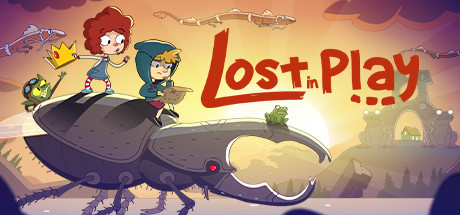
Lost in Play
Albert Einstein once said: “Logic will get you from A to Z; imagination will get you everywhere.” Lost in Play is the perfect embodiment of this quote, as it blends together logical minigames with a story that appears to be born from the imagination of children, and which will transport you – the player – into a fantastic, dream-like realm of endless possibilities.

In Lost in Play you control two siblings – a brother and a sister – who during one sunny day start playing together in their living room and end up drifting into a fantastic world created by their own imagination, in which the things they perceive in reality are projected as surreal shapes and events. They embark on an illusory adventure of finding the way back home, aided by the whimsical characters that the two kids encounter on their path. Their story is contained into 15 short chapters, each of them having a distinctive theme, art style and scenery.

The writing is absolutely stellar. Lost in Play is a game of surprises waiting for you at each step. All the situations that the two children encounter are unexpected and outside our normal way of thinking; the amount of out-of-the box ideas put into the game is astonishing. The characters they encounter and their personalities are also quite unique. There are no horror or negative elements, the game is overloaded with friendliness, positivity and topped off with a very fine sense of humor.

Essentially, Lost in Play is a point & click adventure that’s best described as an interactive cartoon. Compared to other games in the genre, your actions will almost always be clear to you, and the characters you encounter will also make sure to tell you what items they expect you to fetch for them. There aren’t any obtuse situations like in older point & click games, in which you had to pixel-hunt for certain items or use them in very counter-intuitive ways: Lost in Play flows easily and naturally, and how or in what order your inventory items have to be used is pretty straightforward.

On the other hand, the minigames are a mix of easy and tough. Every few chapters you will encounter a minigame on which you might get stuck for 30m – 60m (a variation of checkers, a sokoban-inspired game of aligning crabs and a certain card game are among the most difficult). While Lost in Play is a fairly short game whose core adventure can be completed in less than 2h, the rest of the time will be spent on these minigames, trying and retrying to beat a rather smart AI. The AI’s moves are randomly generated, so there’s no clear recipe on solving them. If I were to complain about something in Lost in Play, that would be the lack of a skip option – the game desperately needs one, especially for younger audiences. Currently there’s no way to progress further apart from retrying a minigame several times until the RNG is in your favor, and then combining it with a strategical and logical approach. There is a hint system, but it’s not very detailed – it only gives you a nudge in the right direction by showing you an image of your next goal in its completed state and not how exactly to reach it.

Lost in Play captivates with its charming hand-drawn, cartoony art style. Transforming your gameplay into an immersive experience and making you feel like a little kid sitting in pajamas in front of the TV watching their favorite cartoon is what the game absolutely shines the brightest at. Also stellar is the soundtrack that perfectly complements the animations. The game is fully voiced, yet the language is unintelligible although the gibberish speech adds a nice nuance which emphasizes even more the idea that whatever happens in the game is surreal.

The game supports three different input schemes: controller, mouse+keyboard or mouse alone. They all function pretty well, and each have advantages / disadvantages in usability. Personally, I preferred playing it with mouse-only since it felt more accessible than the others especially during minigames, while transitioning between scenes was easier with a controller.
There are 19 achievements in the game, most of them being story-related. The missable achievements are easy to obtain even during a first playthrough without using a guide, but the game also has a chapter select in case you skipped any of them. None of them require any finicky skills, nor do they have any time restrictions.

The concept of Lost in Play is a sweet and heartwarming one, showcasing the innocence and the astonishing power of children’s imagination. The game feels very much like a labor of love, given the attention to detail that the developers put into it. Playing it is a wholesome experience, albeit one that is not fully suited for children due to the few difficult puzzles present in the game and the inability to skip them.